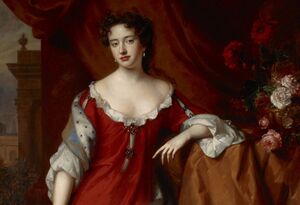Queen Mary of Vionna-Frankenlisch
| Mary | |
|---|---|
| Queen of Vionna-Frankenlisch | |
 | |
| Reign | 15th August 1863 - 14th March 1864 |
| Coronation | 19th August 1863 |
| Predecessor | Edward II |
| Successor | Alexander I |
| Born | Mary Wolsted Saint-Marie Turrell 3 November 1832 Grythshead, Kingdom of Vionna |
| Died | 14 March 1864 (aged 31) |
| Burial | Duchy Cathedral, Grythshead |
| Spouse | Frederick of Saxondale (m. 1849–1852); his death |
| Issue | Alexander I |
| Dynasty | Turrell |
| Father | Edward II |
| Religion | Frankenlischian Andyism |
Mary was Queen of Vionna-Frankenlisch and Frankenlischian Empress from 15th August 1863 to her assassination on 14th March 1864. Her reign of 212 days one of three Vionna-Frankenlischian monarchs to have lasted less than a year, outlasting only Richard I, who was deposed, and Richard II who died of illness after 85 days.
The third child of Edward II and his only daughter, Mary was never expected to take the throne of Vionna-Frankenlisch. However, circumstances forced her into the role after the untimely battle deaths of her two elder brothers, James and Harold at the Battle of Penstle and Harold at the Battle of Barfleur Bay respectively. Mary's younger brother William became Prince Imperial but in 1863 he also died, this time of a sudden illness which also claimed the life of the King. With no other alternative, Mary was made Queen and coronated on 19th August 1863.
Queen Mary's short reign was not remarkable in any particular way. It followed a period of heavy warfare under Edward II and saw the begining of a period of peace and prosperity which came to a head under Alexander I, Mary's successor. Considered naive and flighty, Mary had married young to the Duke of Saxondale and gave birth to a son, Alexander. The Duke of Saxondale died after only three years of marriage and Mary did not marry again, steadily gaining a (possibly undeserved) reputation for promiscuity amongst the Court of Saint Romulus. She hosted many parties and revelled in tournaments and public festivals. Though this made her popular with the common people of her kingdom, Mary was decidedly naive and inept at politics, she did not involve herself in court intrigue and refused to work closely with her government. After seven months a plot by her opposition at court succeeded in assassinating the young Queen, exploiting a lack of security to murder her at a country festival.
Childhood
Mary was born at Grythshead on the 3rd of November 1832, in the latter days of the reign of her grandfather, Edward I. She was the third of the four children of Edward, Duke of Grythshead (later Edward II) and his wife Sarah. She was a healthy baby and was initiated into the Church by High Archbishop Calis IV three months after her birth.
Described as a lively and active child, Mary was not gifted intellectually and little attention was given to her education. Though the Imperial Family adhered to the aristocratic traditions of relative gender equality, Mary was never taken seriously as a candidate for civil or military office partly because she had two elder brothers. She was granted a title, as was usual of the period, on her twelth birthday. Though often old or defunct lordships were presented to royal children, Mary was granted a new title, the Viscouncy of Emmeretton in the Duchy of Gestoria.
From age six until fourteen, Mary was educated by tutors at court and did not exceed at her studies. She left education at fourteen years of age with a strong grip on basic mathematic and literary skills but only a rudimentary knowledge of anything further. She was presented at court on her fifteenth birthday and immediately caught the eye of the young Duke of Saxondale, Frederick. The pair courted for two years and were swiftly married in 1849 when it was discovered that Mary was with child. A son, Alexander was born on 1st June 1849, five months after the wedding of Mary and Frederick.